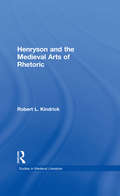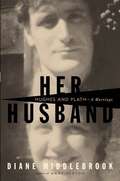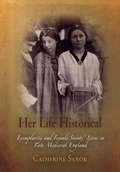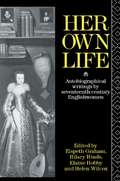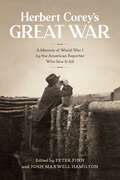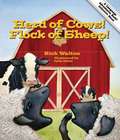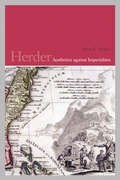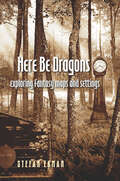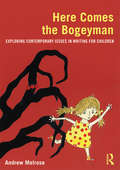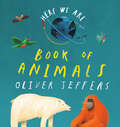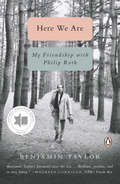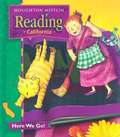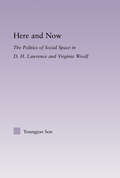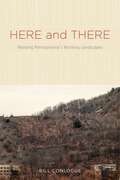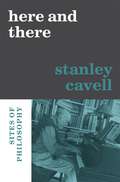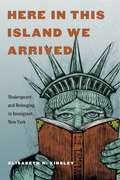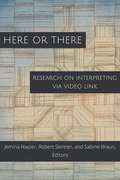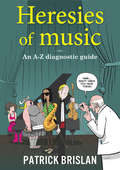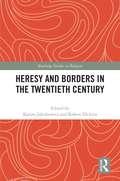- Table View
- List View
Henryson and the Medieval Arts of Rhetoric (Studies in Medieval Literature #8)
by Robert L. KindrickFirst published in 1993. Volume 8 in the 9-volume set of Studies in Medieval Literature, a series of interpretative and analytic studies of the Western European literatures of the Middle Ages. This volume extends the canon of works to be read and studied by providing a new framework for understanding that will inspire students and scholars to look anew at Robert Henryson's poetry. The reader will find it rewarding to read the mainline exposition but will also find a second reward in the knowledge accumulated to support that exposition.
Her Husband: Hughes and Plath -- A Marriage
by Diane MiddlebrookTed Hughes married Sylvia Plath in 1956, at the outset of their brilliant careers. Plath's suicide six and a half years later, for which many held Hughes accountable, changed his life, his closest relationships, his standing in the literary world, and the style and substance of his verse. In this stunning new biography of their marriage, Diane Middlebrook presents a portrait of Hughes as a man, as a poet, and as a husband haunted--and nourished--his entire life by the aftermath of his first marriage. Drawing on a trove of newly available papers Middlebrook presents Hughes as a complicated, conflicted figure: sexually magnetic, fiercely ambitious, immensely caring, and shrewd in business. She argues that Plath's suicide, though it devastated Hughes and made him vulnerable to the savage attacks of Plath's growing readership, ultimately gave him his true subject--how marriages fail and how men fail in marriage. Writing with the penetrating insight and lucid sympathy that informed her previous bestselling biographies, Middlebrook rises to the multiple challenges presented by this highly fraught, deeply controversial subject. Her Husband is a triumph of the biographer's art and craft.
Her Life Historical
by Catherine SanokHer Life Historical offers a major reconsideration of one of the most popular narrative forms in late medieval England--the lives of female saints--and one of the period's primary modes of interpretation--exemplarity. With lucidity and insight, Catherine Sanok shows that saints' legends served as vehicles for complex considerations of historical difference and continuity in an era of political crisis and social change. At the same time, they played a significant role in women's increasing visibility in late medieval literary culture by imagining a specifically feminine audience.Sanok proposes a new way to understand exemplarity--the repeated injunction to imitate the saints--not simply as a prescriptive mode of reading but as an encouragement to historical reflection. With groundbreaking originality, she argues that late medieval writers and readers used religious narrative, and specifically the legends of female saints, to think about the historicity of their own ethical lives and of the communities they inhabited. She explains how these narratives were used in the fifteenth century to negotiate the urgent social concerns occasioned by political instability and dynastic conflict, by the threat of heresy and the changing status of public religion, and by new kinds of social mobility and forms of collective identity.Her Life Historical also offers a fresh account of how women came to be visible participants in late medieval literary culture. The expectation that they formed a distinct audience for saints' lives and moral literature allowed medieval women to surface in the historical record as book owners, patrons, and readers. Saints' lives thereby helped to invent the idea of a gendered audience with a privileged affiliation and a specific response to a given narrative tradition.
Her Own Life: Autobiographical Writings by Seventeenth-Century Englishwomen
by Elspeth Graham Helen Wilcox Hilary Hinds Elaine HobbyDuring a period when writing was often the only form of self-expression for women, Her Own Life contains extracts from the autobiographical texts of twelve seventeenth-century women addressing a wide range of issues central to their lives.
Herbert Corey’s Great War: A Memoir of World War I by the American Reporter Who Saw It All
by Peter Finn and John Maxwell HamiltonIn 1914, the Associated Newspapers sent correspondent Herbert Corey to Europe on the day Great Britain declared war on Germany. During the Great War that followed, Corey reported from France, Britain, and Germany, visiting the German lines on both the western and eastern fronts. He also reported from Greece, Italy, Switzerland, Holland, Belgium, and Serbia. When the Armistice was signed in November 1918, Corey defied the rules of the American Expeditionary Forces and crossed into Germany. He covered the Paris Peace Conference the following year. No other foreign correspondent matched the longevity of his reporting during World War I. Until recently, however, his unpublished memoir lay largely unnoticed among his papers in the Library of Congress.With publication of Herbert Corey’s Great War, coeditors Peter Finn and John Maxwell Hamilton reestablish Corey’s name in the annals of American war reporting. As a correspondent, he defies easy comparison. He approximates Ernie Pyle in his sympathetic interest in the American foot soldier, but he also told stories about troops on the other side and about noncombatants. He is especially illuminating on the obstacles reporters faced in conveying the story of the Great War to Americans. As his memoir makes clear, Corey didn’t believe he was in Europe to serve the Allies. He viewed himself as an outsider, one who was deeply ambivalent about the entry of the United States into the war. His idiosyncratic, opinionated, and very American voice makes for compelling reading.
Herd of Cows! Flock of Sheep! An Adventure in Collective Nouns
by Rick Walton Julie OlsonWhat's more fun than a clowder of cats, a rafter of turkeys, a swarm of bees, or a pack of dogs? Herd of Cows! Flock of Sheep!-the latest word play from the king of language arts picture books, Rick Walton. After bringing in his corn, potatoes, beans, and tomatoes before a rainstorm, Farmer Bob decides to settle down for a good night's rest. While he snoozes away, the river rises high enough to set his bed afloat down the river. This sends his animalsinto a panic-a drove of pigs outlines a plan, a colony of beavers races to chew down trees, a school of fish tries to create a dam, and so forth, until finally Farmer Bob is rescued by a nest of snakes and a herd of horses. It's a barnyard adventure that will leave bands of children begging for more.
Herder
by John K. NoyesAmong his generation of intellectuals, the eighteenth-century German philosopher Johann Gottfried Herder is recognized both for his innovative philosophy of language and history and for his passionate criticism of racism, colonialism, and imperialism. A student of Immanuel Kant, Herder challenged the idea that anyone - even the philosophers of the Enlightenment - could have a monopoly on truth.In Herder: Aesthetics against Imperialism, John K. Noyes plumbs the connections between Herder's anti-imperialism, often acknowledged but rarely explored in depth, and his epistemological investigations. Noyes argues that Herder's anti-rationalist epistemology, his rejection of universal conceptions of truth, knowledge, and justice, constitutes the first attempt to establish not just a moral but an epistemological foundation for anti-imperialism. Engaging with the work of postcolonial theorists such Dipesh Chakrabarty and Gayatri Spivak, this book is a valuable reassessment of Enlightenment anti-imperialism that demonstrates Herder's continuing relevance to postcolonial studies today.
Here Be Dragons: Exploring Fantasy Maps and Settings
by Stefan Ekman Stefar EkmanFirst in-depth study of the use of landscape in fantasy literatureWinner of the Mythopoeic Scholarship Award for Myth and Fantasy Studies (2016) Fantasy worlds are never mere backdrops. They are an integral part of the work, and refuse to remain separate from other elements. These worlds combine landscape with narrative logic by incorporating alternative rules about cause and effect or physical transformation. They become actors in the drama—interacting with the characters, offering assistance or hindrance, and making ethical demands. In Here Be Dragons, Stefan Ekman provides a wide-ranging survey of the ubiquitous fantasy map as the point of departure for an in-depth discussion of what such maps can tell us about what is important in the fictional worlds and the stories that take place there. With particular focus on J. R. R. Tolkien's The Lord of the Rings, Ekman shows how fantasy settings deserve serious attention from both readers and critics. Includes insightful readings of works by Steven Brust, Garth Nix, Robert Holdstock, Terry Pratchett, Charles de Lint, China Miéville, Patricia McKillip, Tim Powers, Lisa Goldstein, Steven R. Donaldson, Robert Jordan, and Neil Gaiman and Charles Vess.
Here Comes the Bogeyman: Exploring contemporary issues in writing for children
by Andrew MelroseHere Comes the Bogeyman is an essential text focussing on critical and contemporary issues surrounding writing for children. Containing a critically creative and a creatively critical investigation of the cult and culture of the child and childhood in fiction and non-fictional writing, it also contains a wealth of ideas and critical advice to be shared with writers, students of children’s writing and students of writing. With scores of published children’s fiction books and films to his name, Andrew Melrose shares his extensive critical, teaching, writing and research experience to provide: a critical and creative investigation of writing and reading for children in the early, middle and pre-teen years an accessible and critically important challenge to the latest international academic research and debates in the field of children’s literature and creative writing. an evaluation of what it means to write for a generation of media-savvy children encouragement for critics, writers and students to develop their own critical, creative and writing skills in a stimulating and supportive manner guidance on writing non-fiction and poetry creative writing craftwork ideas which could be used as seminar topics or as individual reflections This ‘one-stop’ critical and creative text will be an indispensable resource for critics, writers and students interested in the cult and culture of writing for children; on Creative Writing BA and MA programmes; Children's Literature BA and MA programmes; English BA and MA programmes; Teacher Training, PGCE students and for those studying at Doctoral and Post-Doctoral level who are interested in writing for children.
Here We Are: Book of Animals
by Oliver JeffersFrom Oliver Jeffers, world-renowned picture book creator of the #1 New York Times bestseller Here We Are, comes a charming board book companion all about the animals we share our planet with, from A to Z!We share our planet with animals. They come in many shapes, sizes and colors. Inspired by the bestselling picture book, Here We Are, comes this irresistible alphabet book to welcome babies and toddlers to our planet. Praise for Here We Are: -"Moments of human intimacy jostle with scenes that inspire cosmic awe, and the broad diversity of Jeffers's candy-colored humans...underscores the twin messages that 'You're never alone on Earth' and that we're all in this together."--Publisher's Weekly (starred review) -"A sweet and tender distillation of what every Earthling needs to know and might well spend a lifetime striving to achieve. A must-purchase for new parent shelves." --School Library Journal -"From the skies to the animal kingdom to the people of the world and lots of other beautifully rendered examples of life on Earth, Here We Are carries a simple message: Be kind." --NPR -"A true work of art."--Buzzfeed -"A must-have book for parents."--Gambit -"A celebration of people all shapes and sizes, and of the beauty and mystery of our Earth."--Booklist -"Something of a user's guide to being alive and to life on Earth, Jeffers brilliantly uses pen and paintbrush to explore profound and puzzling questions, establishing straight off that the wisdom imparted here is wisdom for us all."--Chicago Tribune
Here We Are: My Friendship with Philip Roth
by Benjamin TaylorA deeply felt, beautifully crafted meditation on friendship and loss in the vein of A Year of Magical Thinking, and a touching portrait of Philip Roth from his closest friend.I had a baseball question on the tip of my tongue: What was the name of "the natural," the player shot by a stalker in a Chicago hotel room? He gave me an amused look that darkened in-to puzzlement, then fear. Then he pitched forward into the soup, unconscious. When I entered the examining room twenty minutes after our arrival at Charlotte Hungerford Hospital, Philip said, "No more books." Thus he announced his retirement.So begins Benjamin Taylor's Here We Are, the unvarnished portrait of his best friend and one of America's greatest writers. Needless to say, Philip Roth's place in the canon is secure, but what is less clear is what the man himself was like. In Here We Are, Benjamin Taylor's beautifully constructed memoir, we see him as a mortal man, experiencing the joys and sorrows of aging, reflecting on his own writing, and doing something we all love to do: passing the time in the company of his closest friend. Here We Are is an ode to friendship and its wondrous ability to brighten our lives in unexpected ways. Benjamin Taylor is one of the most talented writers working today, and this new memoir pays tribute to his friend, in the way that only a writer can. Roth encouraged him to write this book, giving Taylor explicit instructions not to sugarcoat anything and not to publish it until after his death. Unvarnished and affectionately true to life, Taylor's memoir will be the definitive account of Philip Roth as he lived for years to come.
Here We Go! (California)
by J. David Cooper John J. Pikulski Patricia A. AckermanNIMAC-sourced textbook
Here and Now: The Politics of Social Space in D.H. Lawrence and Virginia Woolf (Literary Criticism and Cultural Theory)
by Youngjoo SonWorking at the crossroads of contemporary geographical and cultural theory, the book explores how social spaces function as sites which foreground D. H. Lawrence and Virginia Woolf's critiques of the social order and longings for change. Looking at various social spaces from homes to nations to utopian space brought into the here and now the book shows the ways in which these writers criticize and deconstruct the contemporary symbolic, physical, and discursive spatial topoi of the dominant socio-spatial order and envision a more liberating and inclusive human geography. In addition, the book calls for the need to redress the tendency of some spatial theories to underestimate the political potential of literary discourse about space, instead of simply and mechanically appropriating some theoretical concepts to literary criticism. One of the central findings in the book, therefore, is that literary texts can perform subversive interventions in the production of social space through their critical interaction with dominant spatial codes.
Here and There: Reading Pennsylvania's Working Landscapes
by Bill ConlogueThe global economy threatens the uniqueness of places, people, and experiences. In Here and There, Bill Conlogue tests the assumption that literature and local places matter less and less in a world that economists describe as “flat,” politicians believe has “globalized,” and social scientists imagine as a “global village.” Each chapter begins at home, journeys elsewhere, and returns to the author’s native and chosen region, northeastern Pennsylvania. Through the prisms of literature and history, the book explores tensions and conflicts within the region created by national and global demand for its resources: fertile farmland, forest products, anthracite coal, and college-educated young people. Making connections between local and global environmental issues, Here and There uses the Pennsylvania watersheds of urban Lackawanna and rural Lackawaxen to highlight the importance of understanding and protecting the places we call home.
Here and There: Reading Pennsylvania's Working Landscapes
by Bill ConlogueThe global economy threatens the uniqueness of places, people, and experiences. In Here and There, Bill Conlogue tests the assumption that literature and local places matter less and less in a world that economists describe as “flat,” politicians believe has “globalized,” and social scientists imagine as a “global village.” Each chapter begins at home, journeys elsewhere, and returns to the author’s native and chosen region, northeastern Pennsylvania. Through the prisms of literature and history, the book explores tensions and conflicts within the region created by national and global demand for its resources: fertile farmland, forest products, anthracite coal, and college-educated young people. Making connections between local and global environmental issues, Here and There uses the Pennsylvania watersheds of urban Lackawanna and rural Lackawaxen to highlight the importance of understanding and protecting the places we call home.
Here and There: Sites of Philosophy
by Stanley CavellThe first posthumous collection from the writings of Stanley Cavell, shedding new light on the distinctive vision and intellectual trajectory of an influential American philosopher. For Stanley Cavell, philosophy was a matter of responding to the voices of others. Throughout his career, he articulated the belief that words spring to life in concrete circumstances of speech: the significance and power of language depend on the occasions that elicit it. When Cavell died in 2018, he left behind some of his own most powerful language—a plan for a book collecting numerous unpublished essays and lectures, as well as papers printed in niche journals. Here and There presents this manuscript, with thematically relevant additions, for the first time. These writings, composed between the 1980s and the 2000s, reflect Cavell’s expansive interests and distinctive philosophical method. The collection traverses all the major themes of his immense body of work: modernity, psychoanalysis, the human voice, moral perfectionism, tragedy, skepticism. Cavell’s rich and cohesive philosophical vision unites his wide-ranging engagement with poets, critics, psychoanalysts, social scientists, and fellow philosophers. In Here and There, readers will find dialogues with Shakespeare, Thoreau, Wittgenstein, Freud, Heidegger, Walter Benjamin, Wallace Stevens, Veena Das, and Peter Kivy, among others. One of the collection’s most striking features is an ensemble of five pieces on music, constituting Cavell’s first discussion of the subject since the mid-1960s. Edited by philosophers who have been invested in Cavell’s work for decades, Here and There not only gathers the strands of a writing life but also maps its author’s intellectual journeys. In these works, Cavell models what it looks like to examine seriously one’s own passions and to forge new communities through unexpected conversations.
Here in This Island We Arrived: Shakespeare and Belonging in Immigrant New York
by Elisabeth H. KinsleyIn this book, Elisabeth H. Kinsley weaves the stories of racially and ethnically distinct Shakespeare theatre scenes in late nineteenth- and early twentieth-century Manhattan into a single cultural history, revealing how these communities interacted with one another and how their work influenced ideas about race and belonging in the United States during a time of unprecedented immigration.As Progressive Era reformers touted the works of Shakespeare as an “antidote” to the linguistic and cultural mixing of American society, and some reformers attempted to use the Bard’s plays to “Americanize” immigrant groups on Manhattan’s Lower East Side, immigrants from across Europe appropriated Shakespeare for their own ends. Kinsley uses archival material such as reform-era handbooks, theatre posters, playbills, programs, sheet music, and reviews to demonstrate how, in addition to being a source of cultural capital, authority, and resistance for these communities, Shakespeare’s plays were also a site of cultural exchange. Performances of Shakespeare occasioned nuanced social encounters between New York’s empowered and marginalized groups and influenced sociocultural ideas about what Shakespeare, race, and national belonging should and could mean for Americans.Timely and immensely readable, this book explains how ideas about cultural belonging formed and transformed within a particular human community at a time of heightened demographic change. Kinsley’s work will be welcomed by anyone interested in the formation of national identity, immigrant communities, and the history of the theatre scene in New York and the rest of the United States.
Here in This Island We Arrived: Shakespeare and Belonging in Immigrant New York
by Elisabeth H. KinsleyIn this book, Elisabeth H. Kinsley weaves the stories of racially and ethnically distinct Shakespeare theatre scenes in late nineteenth- and early twentieth-century Manhattan into a single cultural history, revealing how these communities interacted with one another and how their work influenced ideas about race and belonging in the United States during a time of unprecedented immigration.As Progressive Era reformers touted the works of Shakespeare as an “antidote” to the linguistic and cultural mixing of American society, and some reformers attempted to use the Bard’s plays to “Americanize” immigrant groups on Manhattan’s Lower East Side, immigrants from across Europe appropriated Shakespeare for their own ends. Kinsley uses archival material such as reform-era handbooks, theatre posters, playbills, programs, sheet music, and reviews to demonstrate how, in addition to being a source of cultural capital, authority, and resistance for these communities, Shakespeare’s plays were also a site of cultural exchange. Performances of Shakespeare occasioned nuanced social encounters between New York’s empowered and marginalized groups and influenced sociocultural ideas about what Shakespeare, race, and national belonging should and could mean for Americans.Timely and immensely readable, this book explains how ideas about cultural belonging formed and transformed within a particular human community at a time of heightened demographic change. Kinsley’s work will be welcomed by anyone interested in the formation of national identity, immigrant communities, and the history of the theatre scene in New York and the rest of the United States.
Here or There: Research on Interpreting via Video Link (Gallaudet Studies In Interpret #16)
by Robert Skinner Jemina Napier Sabine BraunThe field of sign language interpreting is undergoing an exponential increase in the delivery of services through remote and video technologies. The nature of these technologies challenges established notions of interpreting as a situated, communicative event and of the interpreter as a participant. As a result, new perspectives and research are necessary for interpreters to thrive in this environment. This volume fills that gap and features interdisciplinary explorations of remote interpreting from spoken and signed language interpreting scholars who examine various issues from linguistic, sociological, physiological, and environmental perspectives. Here or There presents cutting edge, empirical research that informs the professional practice of remote interpreting, whether it be video relay service, video conference, or video remote interpreting. The research is augmented by the perspectives of stakeholders and deaf consumers on the quality of the interpreted work. Among the topics covered are professional attitudes and motivations, interpreting in specific contexts, and adaptation strategies. The contributors also address potential implications for relying on remote interpreting, discuss remote interpreter education, and offer recommendations for service providers.
Heresies of Music: An A-Z diagnostic guide
by Patrick BrislanWhat is Lisztomania, and how was it cured? Who was Drog, and what was his prophecy regarding Electronic Music? What preparation do you need before throwing an artistic tantrum? Which orchestral musicians are also qualified to run a hospital? The plausible answers to these and many other tantalising questions can be found in this wickedly funny - and occasionally just wicked - book. The many commonly-used descriptions of some of the best known identities and institutions of music are 'diagnosed' to reveal something very different from the accepted truths about such icons. Conductors, music critics, composers, radio presenters, singers, pianists and others are shown in a very different light. These alternate views, or 'heresies' are assembled conveniently in alphabetical order. Under U is for Understudy for example, can be found a variety of different reasons why understudies, far from being hailed as saviours, are so widely disliked. Because music critics will probably be discomforted by what they find inside, it is extremely unlikely any will choose to review this book. The author has been compelled therefore to write his own critical quotes. Here are some favourable ones: '... A wonderful collection of truths, and almost all are inconvenient'. '... Something here to offend everyone'. '... Everything from burlesque to parody, and with a sprinkling of serious commentary to confound the believers'. In the interest of balance however, here are some quotes from reviews which might have been written by others less inclined to view Heresies favourably. Again, the author has undertaken this task on their behalf: "...a random assortment of schoolboy jokes. Possibly enjoyable for those who like juvenile humour - assuming they find it funny at all." "The attempts at serious commentary are laughable, while the so-called heretical viewpoints are the unfunny fancies of a feeble mind." "... Betrays an underlying resentment - disguised as 'heresy' - of those of eminence and achievement in music's historical record." Hmm. Can they all be right?
Heresy Trials and English Women Writers, 1400-1670
by Genelle GertzThis book charts the emergence of women's writing from the procedures of heresy trials and recovers a tradition of women's trial narratives from the late Middle Ages to the seventeenth century. Analyzing the interrogations of Margery Kempe, Anne Askew, Marian Protestant women, Margaret Clitherow and Quakers Katherine Evans and Sarah Cheevers, the book examines the complex dynamics of women's writing, preaching and authorship under religious persecution and censorship. Archival sources illuminate not only the literary choices women made, showing how they wrote to justify their teaching even when their authority was questioned, but also their complex relationship with male interrogators. Women's speech was paradoxically encouraged and constrained, and male editors preserved their writing while shaping it to their own interests. This book challenges conventional distinctions between historical and literary forms while identifying a new tradition of women's writing across Catholic, Protestant and Sectarian communities and the medieval/early modern divide.
Heresy and Borders in the Twentieth Century (Routledge Studies in Religion)
by Karina JakubowiczThis book explores the shifting and negotiated boundaries of religion, spirituality, and secular thinking in Britain and North America during the twentieth century. It contributes to a growing scholarship that problematises secularization theory, arguing that religion and spirituality increasingly took diverse new forms and identities, rather than simply being replaced by a monolithic secularity. The volume examines the way that thinkers, writers, and artists manipulated and reimagined orthodox belief systems in their work, using the notion of heresy to delineate the borders of what was considered socially and ethically acceptable. It includes topics such as psychospiritual approaches in medicine, countercultures and religious experience, and the function of blasphemy within supposedly secular politics. The book argues that heresy and heretical identities established fluid borderlands. These borderlands not only blur simple demarcations of the religious and secular in the twentieth century, but also infer new forms of heterodoxy through an exchange of ideas. This collection of essays offers a nuanced take on a topic that pervades the study of religion. It will be of great use to scholars of Heresy Studies, Religious Studies and Comparative Religion, Social Anthropology, History, Literature, Philosophy, and Cultural Studies.
Heresy, Literature, and Politics in Early Modern English Culture
by David Loewenstein John MarshallThis interdisciplinary volume of essays brings together a team of leading early modern historians and literary scholars in order to examine the changing conceptions, character, and condemnation of 'heresy' in sixteenth- and seventeenth-century England. Definitions of 'heresy' and 'heretics' were the subject of heated controversies in England from the English Reformation to the end of the seventeenth century. These essays illuminate the significant literary issues involved in both defending and demonising heretical beliefs, including the contested hermeneutic strategies applied to the interpretation of the Bible, and they examine how debates over heresy stimulated the increasing articulation of arguments for religious toleration in England. Offering fresh perspectives on John Milton, Thomas Hobbes, John Locke and others, this volume should be of interest to all literary, religious and political historians working on early modern English culture.
